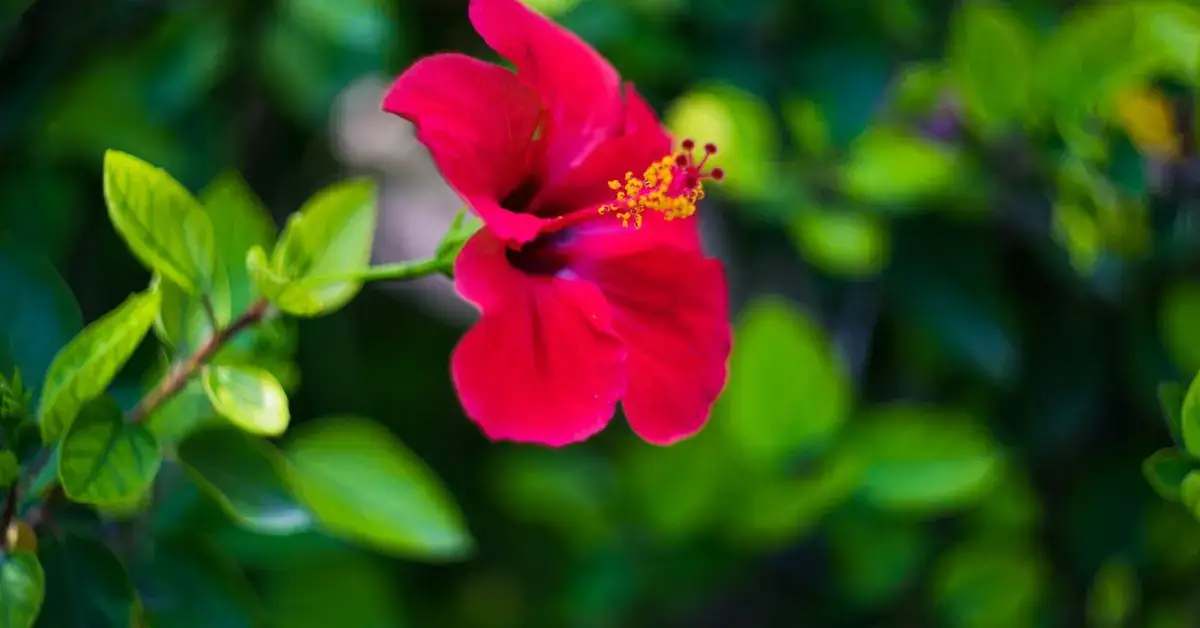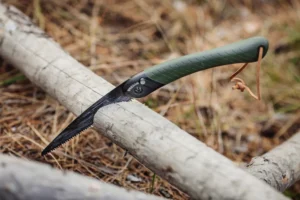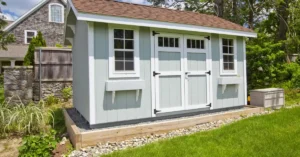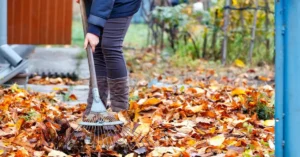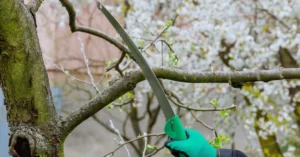Garden enthusiasts looking to add vibrant, eye-catching blooms to their outdoor space can’t go wrong with the hibiscus flower. These beauties can instantly brighten up any garden.
First, it’s essential to know the difference between hardy and tropical varieties since each has unique needs.
To plant your hibiscus, use a well-draining potting mix, place it in a sunny spot, and water it regularly, but be careful to avoid waterlogging.
Feeding your plant every two weeks during the growing season and pruning in early spring will keep it healthy and blooming.
Ready to make your hibiscus thrive and tackle common issues?
What Types of Hibiscus Are There?
When it comes to hibiscus, you’ve got plenty of options to choose from.
There are hardy hibiscus and tropical hibiscus, each with its own unique features.
We’ll also look at some popular species and help you decide which type is perfect for your garden.
Exploring Hardy Hibiscus vs Tropical Hibiscus
Hibiscus flowers come in two main types – hardy hibiscus and tropical hibiscus – each with unique characteristics and growing needs.
Hardy hibiscus, such as Hibiscus syriacus, can survive cold winters and thrive in various climates. They’re perfect if you live in an area with a short growing season.
On the other hand, tropical hibiscus, like Hibiscus rosa-sinensis, prefer warm, sunny environments and can’t tolerate frost. If you live in a warmer climate or can grow them indoors, these vibrant flowers are a great choice.
Understanding these differences helps you choose the right hibiscus for your garden, ensuring beautiful blooms and healthy plants year-round.
Popular Hibiscus Species and Their Characteristics
Now that you know the differences between hardy and tropical hibiscus, let’s explore some popular hibiscus species and their unique characteristics.
Hibiscus moscheutos, also known as the swamp rose mallow, boasts large, showy flowers and can thrive in wet conditions.

Hibiscus coccineus, or the scarlet hibiscus, features striking red flowers and is perfect for adding a pop of color.

Hibiscus mutabilis, often called the Confederate rose, is fascinating because its flowers change color from white to pink to red over a single day.

The yellow Hawaiian hibiscus, known as Hibiscus brackenridgei, is Hawaii’s state flower and is native to the islands. This vibrant flower thrives in dry forests and shrublands, adding a splash of bright yellow to the landscape.

Finally, the Chinese hibiscus, or Hibiscus rosa-sinensis, is a tropical favorite known for its vibrant and varied colors.

Each hibiscus species brings its own beauty and charm to your garden.
Choosing the Right Type of Hibiscus for Your Garden
Selecting the right type of hibiscus for your garden depends on your climate, space, and personal preference. The hibiscus genus offers many options. Hardy varieties, like Hibiscus syriacus, thrive in colder climates, while tropical hibiscus prefers warmer areas. Both types need well-drained soil with a proper soil pH and direct sunlight for ideal growth.
Here’s a quick comparison:
| Type | Best For |
| Tropical Hibiscus | Warm climates |
| Hardy Hibiscus | Colder climates |
| Perennial Hibiscus | Seasonal gardens |
| Annual Hibiscus | Short-term beauty |
In the United States, your choice might vary from North to South. Always consider your local climate and garden space to pick the perfect hibiscus for your needs.
How to Plant Hibiscus Flower?

Planting hibiscus flowers is easy if you know the right steps.
Start by choosing a sunny spot with well-draining soil, and consider whether you want to plant seeds or use pots.
Let’s explore the key tips to make your hibiscus thrive from the ground up.
Steps to Successfully Plant Hibiscus From Seed
To plant hibiscus from seed, start by soaking the seeds in warm water for a few hours to soften their hard shells.
Next, fill small pots with a well-draining potting mix. Plant the seeds about 1/4 inch deep in the soil. Keep the soil moist but not soggy, and place the pots in a sunny spot with temperatures between 60-75°F.
Your hibiscus flower will thrive with plenty of sunlight and warmth. Be patient, as germination can take a few weeks.
- Excitement: Watching your hibiscus sprout from a tiny seed!
- Joy: Seeing those first green shoots emerge.
- Pride: Successfully growing hibiscus from scratch.
- Anticipation: Waiting for those stunning blooms to appear.
Key Tips for Planting Hibiscus in Pots

When planting hibiscus in pots, make sure you choose a container with good drainage to prevent waterlogged roots.
Place your potted hibiscus near a sunny window where it can get plenty of light. Use a well-draining potting mix and water the plant regularly, but don’t let it sit in water.
Feed your hibiscus every two weeks with a liquid fertilizer to encourage healthy growth and vibrant individual flowers.
Keep an eye out for pests like spider mites, which can harm your plant. If you notice them, wash the leaves with soapy water or use a mild insecticide.
With these tips, your potted hibiscus will thrive and bring beauty to your home.
Site Selection: Full Sun and Soil Requirements

Choosing the right site for your hibiscus is essential, so aim for a sunny spot with well-draining soil to guarantee your flowers flourish.
Hibiscus plants thrive in full sun, which means they need at least six hours of direct sunlight each day.
Proper soil requirements are also key; make certain the soil is rich in organic matter and drains well to keep your hibiscus happy and healthy.
Remember, good site selection leads to:
- Vibrant blooms that brighten your garden
- Lush green foliage that showcases your plant’s health
- Strong roots that anchor and nourish your hibiscus
- Thriving hibiscus plants that bring joy all season long
How to Provide Optimal Hibiscus Care?
To keep your hibiscus thriving, you’ll need to focus on proper watering and fertilizing, managing common diseases, and mastering pruning and repotting techniques.
Ensuring these aspects are well-handled will help your hibiscus bloom beautifully.
Let’s explore how to give your hibiscus the best care possible.
Watering and Fertilizing Hibiscus Plants

Ensuring your hibiscus plants thrive involves providing the right balance of water and nutrients.
Water your hibiscus flowers regularly, but don’t let the soil become waterlogged. Aim for moist, well-drained soil to prevent root rot and other plant diseases. Flower buds can drop if the plant gets too dry.
Fertilize your hibiscus blooms every two weeks during the growing season with a balanced, water-soluble fertilizer. Avoid using too much nitrogen, as it can hinder flowering and lead to insufficient light reaching the lower leaves.
Remember the joy of seeing vibrant hibiscus blooms in your garden.
Feel the satisfaction of healthy, thriving plants.
Experience the delight in every new flower bud.
Avoid the disappointment of struggling with plant diseases.
Dealing with Common Hibiscus Plant Diseases
When caring for your hibiscus plants, recognizing and addressing common diseases early is crucial to keep them healthy and vibrant.
Hibiscus will benefit from staying indoors in a warm environment, especially if temperatures drop below 90 degrees.
If you spot pests like aphids or spider mites, use insecticidal soaps to treat them. These soaps are gentle on your plants but effective against pests.
Ensuring proper air circulation and not overwatering can also prevent fungal diseases.
Best Practices for Pruning and Repotting Hibiscus

Pruning and repotting your hibiscus are essential tasks that keep the plant healthy and encourage vibrant blooms.
When caring for hibiscus, start by pruning in early spring to shape the plant and remove dead or weak branches. This is especially important for swamp hibiscus and older varieties.
Regular pruning helps your hibiscus produce more flowers, whether they’re single or double blooms.
Repotting is another vital step. Do it every two to three years to give the roots more room and fresh soil.
Hibiscus plants, common in North America, thrive when their roots aren’t overcrowded.
Experience the joy of vibrant blooms. Feel the satisfaction of a thriving plant. Enjoy a healthier, more beautiful garden. Create a stunning focal point with your hibiscus.
What Pot is Best for Planting Hibiscus?
When choosing a pot for your hibiscus, consider the pot size and material carefully.
Make sure the pot has proper drainage to prevent water from collecting and causing root rot.
Choosing the Right Pot for Hibiscus Plants

Choosing the right pot for your hibiscus plants is crucial to guarantee they thrive and bloom beautifully. First, guarantee your pot has adequate drainage to prevent root rot. Without proper drainage, your hibiscus might suffer and not reach its full potential.
Next, look for a pot that complements your garden or indoor space, adding beauty and charm to your home. Remember, the visual appeal of your pot can enhance your overall enjoyment of the plant.
Consider these key points:
- Proper drainage holes: Guarantees excess water escapes.
- Aesthetic appeal: Adds to your home’s beauty.
- Durability: Withstands outdoor weather if placed outside.
- Breathability: Allows roots to breathe and grow.
These tips help your hibiscus flourish and brighten your space!
Pot Size and Material Considerations
Ideal Pot Size for Hibiscus Plants
When selecting a pot for your hibiscus, it’s essential to consider the plant’s mature size. A pot that’s too small can restrict root growth, leading to poor health and limited flowering. Conversely, an overly large pot can hold excess water, increasing the risk of root rot.
- Small to Medium Plants: Use a pot that’s 10-12 inches in diameter. This size is ideal for young or small hibiscus plants, allowing enough room for initial growth without overwhelming the roots with too much soil.
- Larger Plants: For more mature hibiscus plants, opt for pots that are 14-18 inches in diameter. This provides ample space for the roots to expand and supports the plant’s structure, especially if it grows tall and heavy with blooms.
- [60OZ LARGE DEEP RESERVOIR, 2~3 WEEKS EXTRA WATER] 12inch Extra large Self Watering Pot with deep reservoir makes it easy for when go on vocation that no need someone to come over water plants and flowers. Built-in tray protects decks, patios, or indoor surfaces. (Dimension: 12” W x 10” H)
- [2IN1 SELF WATERING POTS] The planters has a removable watering feeder. You can watering from bottom directly or watering from the top, the excess water will drip into the bottom reservoir. It prevents root rot, making sure your plants don’t sit in water and have enough air to circulate in the soil. The bottom of the 60oz large reservoir provides optimal moisture for your plants.
Material Considerations
The material of the pot plays a vital role in maintaining the right soil moisture levels and overall plant health. Here are some common materials to consider:
- Terracotta and Clay Pots: These are excellent choices for hibiscus because they are porous, allowing air to reach the roots and excess moisture to evaporate. This helps prevent root rot and promotes healthier root systems. However, they can dry out quickly, so regular watering is necessary.
- Plastic Pots: These are lightweight and retain moisture well, which can be beneficial in hot climates. However, they don’t allow the soil to breathe as much as terracotta or clay pots, which can sometimes lead to overwatering issues.
- Ceramic Pots: Often glazed, ceramic pots offer a balance between aesthetics and functionality. They retain moisture well but may not provide the same level of aeration as unglazed pots. Ensure they have drainage holes to prevent waterlogging.
- Metal and Wooden Pots: These can also be used, but they have specific care needs. Metal pots can heat up and cool down quickly, potentially stressing the plant. Wooden pots, while providing good insulation, can deteriorate over time and may require liners to prevent soil loss.
Proper Drainage to Prevent Plant Diseases
Proper drainage is essential for your hibiscus to thrive and avoid common plant diseases. When choosing a pot, make sure it has drainage holes to let excess water escape. This prevents root rot and keeps your plant healthy.
Clay or terracotta pots are great because they’re porous, helping the soil dry out faster.
Consider these benefits:
Prevents root rot: Keeps roots from sitting in water. Improves aeration: Allows air to reach the roots. Healthier growth: Promotes strong, vibrant plants. Ease of care: Reduces the risk of overwatering.
Make sure to place a saucer under the pot to catch any drained water, but remember to empty it regularly.
This small step can make a big difference in your hibiscus care routine!
What Are Common Issues with Hibiscus Yellowing and Bloom Problems?

Yellowing leaves and bloom problems can be frustrating, but understanding the causes can help you keep your hibiscus healthy.
We’ll explore how to diagnose and prevent yellow leaves, promote abundant blooms, and tackle care in different climates.
Let’s get your hibiscus thriving!
Diagnosing and Preventing Yellow Leaves on Hibiscus
Ever wonder why your hibiscus leaves are turning yellow and the blooms aren’t thriving?
It’s frustrating, but understanding the causes can help.
One common issue is overwatering. Hibiscus plants don’t like soggy soil, which causes root rot and yellow leaves.
Another culprit could be nutrient deficiency. Hibiscus needs regular feeding to stay healthy.
Pests like aphids and spider mites also stress your plant, leading to yellowing.
Finally, temperature changes can shock your hibiscus, causing both yellow leaves and poor blooms.
Overwatering: Root rot and yellow leaves
Nutrient Deficiency: Needs regular feeding
Pests: Aphids and spider mites stress the plant
Temperature Changes: Shock causes yellowing and poor blooms
How to Ensure Your Hibiscus Blooms Abundantly

To guarantee your hibiscus blooms abundantly, start by giving it the right balance of water, nutrients, and sunlight.
Water your plant regularly but make certain the soil drains well to avoid root rot. Hibiscus loves sunlight, so place it where it gets at least six hours of direct sun each day.
Fertilize your hibiscus every two weeks during its growing season with a balanced fertilizer.
If your plant’s leaves turn yellow, it could be due to overwatering or a lack of nutrients. Inspect the plant for pests like aphids or spider mites, which can hinder blooms.
Prune your hibiscus to promote new growth and more flowers.
Addressing Hibiscus Care in Different Climates
While maintaining your hibiscus blooms abundantly is important, it’s also vital to understand how different climates can affect its overall health and flowering.
In colder climates, hibiscus plants may face yellowing leaves and stunted blooms due to frost damage. Conversely, in hot, dry regions, they may suffer from dehydration and heat stress.
To help your hibiscus thrive, consider these tips:
- Watering: Make certain of consistent moisture but avoid overwatering.
- Sunlight: Provide ample sunlight, ideally 6-8 hours daily.
- Fertilizing: Use a balanced fertilizer to promote growth and flowering.
- Pest Control: Watch for common pests like aphids and treat promptly.
FAQ Hibiscus Flower
What is hibiscus flower good for?
Hibiscus flowers are known for their health benefits, including lowering blood pressure, aiding digestion, and boosting the immune system. They’re also used in skincare and haircare products.
How long do hibiscus flowers last?
Hibiscus flowers typically last for one to two days, but new blooms can appear daily during the flowering season.
Where do hibiscus flowers grow best?
Hibiscus flowers grow best in warm, tropical climates with well-drained soil. They thrive in USDA zones 9-11.
Do hibiscus plants like sun or shade?
Hibiscus plants prefer full sun but can tolerate partial shade. They need at least 6 hours of sunlight daily for optimal growth and blooming.
Do you have a hibiscus flower in your garden? What is your best tip for this beautiful plant?

